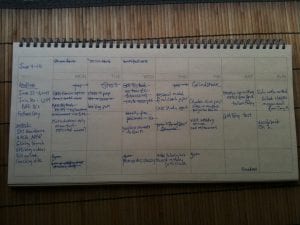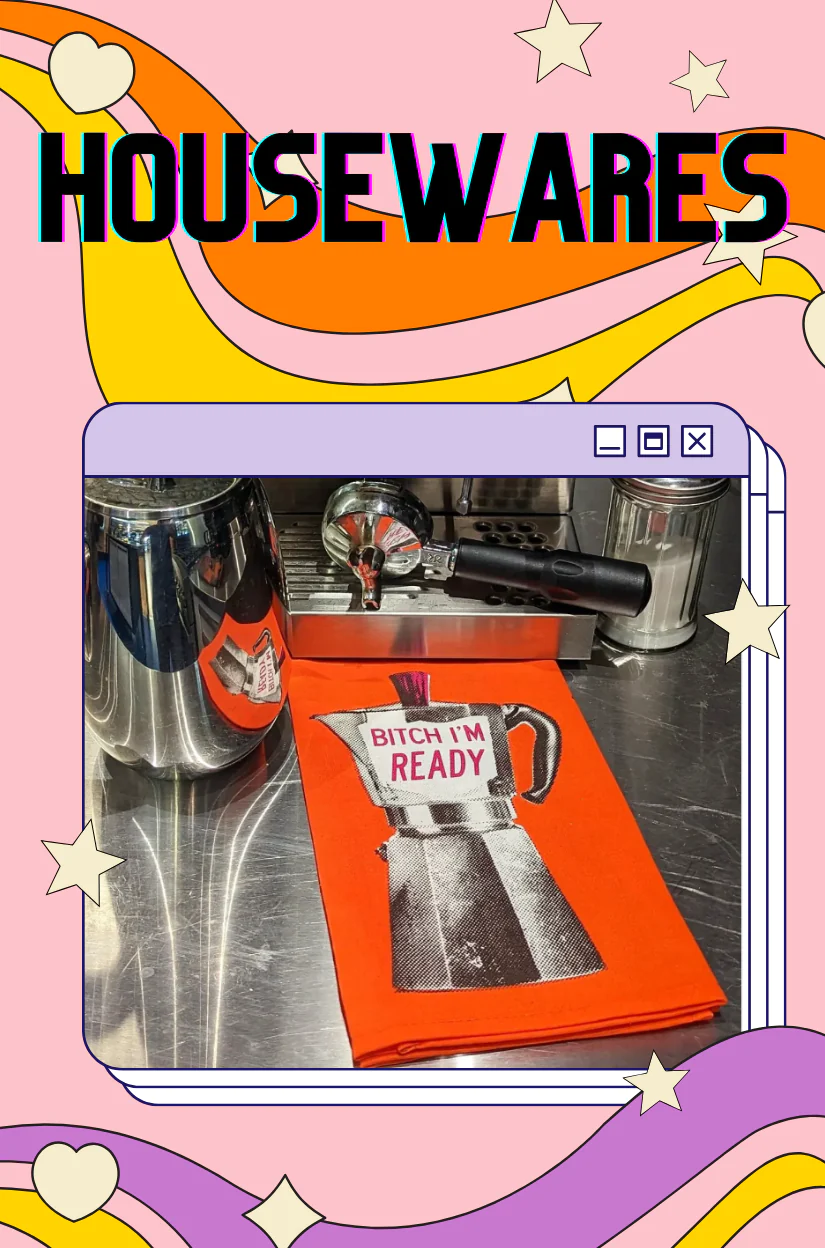Back when I ran a failing dotcom, I used to both joke and despair about my to-do list. My to-do list consisted of:
- Many little slips of paper
- 1-3 legal pads full of scribbles
- 6-8 Word documents labeled “marketing,” “project management,” “personal,” etc., each of which was at least 6 pages long, single-spaced
Six to eight Word documents multiplied by at least six pages apiece, times the number of lines on a page means that just the Word documents alone had thousands of items on them. And then, instead of doing any of these carefully catalogued tasks (or delegating them — I was very bad at delegating), I would spend countless hours transcribing tasks from the legal pads and slips of paper into the Word documents.
When the Word documents got too overwhelming — which was pretty immediately — I would adopt another list, in Apple’s Stickies program or on a little slip of paper, with the things that seemed really important. Soon, that list would grow to be long enough to require segments labeled “marketing,” “project management,” “personal,” etc. Soon: WORMHOLE!
Years later, I dated a guy who ran a successful boutique design firm and whose to-do list was precisely three items long. I was irrationally infuriated by this idea (because my long to-do lists are virtuous because they show that I am beleaguered!)
I asked, “What if you have three important things on there and then AN EMERGENCY HAPPENS?”
He shrugged. “Something gets bumped.”
That approach is still a little extreme for me, and I do think that people who do a lot of things (see here and here) are naturally going to have more complicated lists.
But after many years of to-do list fuckery, I think I’ve worked some things out. I assume you’re already pretty familiar with the standard advice to prioritize and to break big tasks into smaller parts.
Here are some additional to-do’s.
Stuff Humans Are Good At? Use That.
First, lists themselves aren’t that hot. They don’t map up to the actual time you have available. For that, you need some kind of calendar. (For a pretty basic book on estimating how much time each task will take and scheduling those tasks accordingly, see Julie Morgenstern’s Time Management From the Inside Out.)
But your regular calendar, where you log your appointments, isn’t necessarily the place to record every little task. Does it really matter what time of day you “Call Verizon”? And how do you know how long it will take to … oh, say … write an article? Scheduling in tasks for specific timeslots doesn’t usually work unless the tasks are things you are sure you can accomplish in a particular period of time (for instance, working out).
For example, I don’t know how long it will take me to write a Bullish column, and I feel like it’s just too much to schedule it in from 9:30-1:30 — it just never works out that way. Instead, I just write it really big. And I don’t write more than one really big item per day.
More importantly, you can stare at a week’s worth of Outlook appointments — a packed schedule of little virtual time-boxes — and still ask, “What does it all mean?”
I think that taking advantage of some of the natural features of human brains can bring shape and meaning to a weekly plan.
I feel like I revolutionized my life when I found this blank weekly calendar at the MUJI store. It’s large and lives on my desk. It’s pretty enough (if it’s not made from bamboo and fairy dust, I’m pretending that it is) that I don’t carry it around and mess it up.
I don’t write my appointments in it — I use monthly printed-out iCal pages for that. I just cross-reference — at the beginning of the week, I look at my appointments for that week and then write more tasks on the MUJI calendar for days with fewer appointments, and vice-versa. To wit:
OMG, I do things in blue pen! Am I just old?
Well, sort of. (See Bullish: Pre-Internet Productivity Tips for the Young and Sprightly.)
But actually, I hate staring at screens. They mess up your serotonin. They distract and kill time in a way that is disturbingly like television. They’re bad for your eyes. And, pardon me for pointing out that the emperor currently has a dearth of garments, but your eyes can see a much larger visual field than your stupid screen. You make yourself dumber — you limit the powers of your amazing human eyes and brain — when you limit your visual field to a 20-inch monitor.
Even if you have all the best apps in the world, you still have to tab back and forth among them. You lose clarity and concentration when you do that. Maybe you have two monitors! Amazing! Um, I have a desk, a standing desk, and my lap. Those of you in college — ever try to write a paper in Word when all your sources are PDFs and online journal articles? Sometimes you’ve just got to print those fuckers out.
Also, when writing by hand, you naturally make important things larger, and leave more space around those things. In fact, you might, without even thinking about it, write “TAXES” in all-caps and “anniversary dinner” in script. It’s actually kind of hard to accomplish that in most scheduling programs. And this is a kindergarten-level skill — we naturally assign importance to what we are writing when writing by hand.
I also think that making my to-do list a little bit of a craft project provides some mental distance from all the crap blaring at me from my computer. When I want to think about my priorities, I physically shut my laptop (and my life is my own again!)
For those of you outside major metro areas, MUJI sadly does not sell this beautiful weekly calendar online, but they do sell the award-winning Chronotebook!
I don’t even have to explain this — just look at it! It makes perfect visual sense, while also allowing the freedom to sprawl over parts of the page and prioritize as you see fit. You can kind of see the shape that a particular day takes.
Here is a site dedicated to making your own Chronotebook, although you can buy them online for only $5.50.
Adopt a To-Don’t List
Here’s an idea from Peter Bregman’s What’s On Your To-Don’t List? — Accept that you can’t get it all done, and keep a To-Don’t list to make sure that the wrong things don’t take up your limited time.
One item on Bregman’s to-don’t list is not buying another iPad, since the first two wasted so much of his time.
“Things you place on your To-Don’t list don’t have to stay there forever,” Bregman writes. “Some things — like my iPad — I leave on my To-Don’t list for years. Other things — like responding to email, answering my phone or surfing the Web — I place on my To-Don’t list for just a few hours at a time.”
Personally, I like to maintain the illusion that I can do All The Things eventually, and “to-don’t” sounds a little harsh. I mean, I guess I would say that my permanent To-Don’t list includes watching cop shows, eating packaged sandwich bread, and Star magazine (if I’m going to read tabloids, I at least want them to be mostly true). But I don’t need a list for those things.
(See Bullish: How to Motivate Yourself to Be Motivated for more on the power of fear, disgust, and revenge.)
Instead, I have an “On Deck” list (it’s in the lefthand column of my screenshots above). It lists some pretty big projects that are totally on the agenda — but that I just won’t be able to work on this week. So, if I have five classes to teach and two Bullish columns to write and a slew of little phone calls and a proposal and a Powerpoint deck and the cat needs fillings, I can put “web content for my new Christmas-tree delivery business’s website” on deck, and I don’t feel bad about it. Christmas isn’t until December anyway.
Separate Brain Work from Less Brainy Work
In Bullish Life: Breaking Up Is Hard To Do, I wrote that we all have difficult times in our lives, whether it’s that you’re practically brain dead between 5 and 6pm every weekday or whether it’s a 3-month spate of incapacitating breakup grief. You can redeem this time by using it to perform tasks you would normally find boring and tedious:
Grief can be helpful. It drowns out a lot of other things, like muscle soreness from really solid exercising, or boredom from monotonous forms of work. Go organize all the receipts for your taxes. Run. Take the cat to the vet. Do 500 calf raises. Make flashcards of French verb conjugations. Grief will numb you to the little trials and boredoms that bog down happy people.
Just do really productive, somewhat-boring things repetitively and stoically in order to improve your life, so that when you feel better, you’ll look around and say, “Holy shit, the sun is shining again and my job is amazing and I can do six pullups in a row and I speak French?”
Later, below Bullish Life: Bullish Turns Two!, Commenter Eagle Eye posted:
I had an off day a little while ago, I didn’t sleep well the night before or something like that and, as a grad student, my brain was just mush and not prepared for the mountain of reading/ research I had to accomplish. Normally, this would send me into a spiral of panic over all of the work that I needed to do but wasn’t going to complete to the degree that I was happy with.
Instead of just sitting in a panic mode and being totally unproductive, I used that day to tackle off the stupid bull-shitty tasks that are always super boring on good brain days but were perfect for bad brain days. All of my printed out readings were 3-hole punched, stapled and organized into binders depending on the course, I took stock of my research papers and made lists about what books I should start reading once I was back on my game, and I think that I finally cleaned the house and did some laundry.
By the next day I was back to normal and back to work, without feeling horribly guilty about a lost day!
I giggle like a schoolgirl/boy when people go and do things I wrote about! (Note: Boys and girls totally giggle the same until they learn about socially constructed gender roles.)
I keep less brainy tasks in the very bottom box for each day. Then, when my fiance gets home and I’m no longer really writing an article, I can start printing worksheets or wrapping gifts while we chat.
(See also: Bullish Life: A Day in the Life of Bullish – Caffeine, Pinstripe, and a Lack of Time-Wasting Bullshit.)
Can’t Do It All Perfectly? Adopt a Theme.
A friend told me that she was a little bummed because her to-do list always had the same stuff on it — exercise, write more, practice Japanese, eat healthy food — and she felt like she was always failing at something.
I said, “Why not adopt a theme for each week or month?” You can’t give your utmost to four things at once. But you can give your utmost to one of them and still juggle the other three. Why not keep all four things on the list, and at the end of each week, pick a theme — like, “Write like a devil!” or “Juice fast!” or “Japanese immersion!” — for the next week?
I had a similar experience with a client I was coaching, one who was able to adopt a theme for a whole stage of her life — in her case, a theme of exploring and trying new things. More on this topic later!
For now, get your to-do list — or rather, to-do system — in shape! If you’ve been staring at some endless list with no connection to when and how you will do those tasks, of course you’re going to feel like you’re underachieving. In the words of W. Edwards Deming, “A bad system will beat a good person every time.”
A good system alleviates guilt about not accomplishing the impossible, creates feelings of excitement and achievability, and produces results.
This year, Bullicorns are gathering at the first-ever Bullish Conference to revolutionize their 2014 to-do lists. Join them by registering here.













